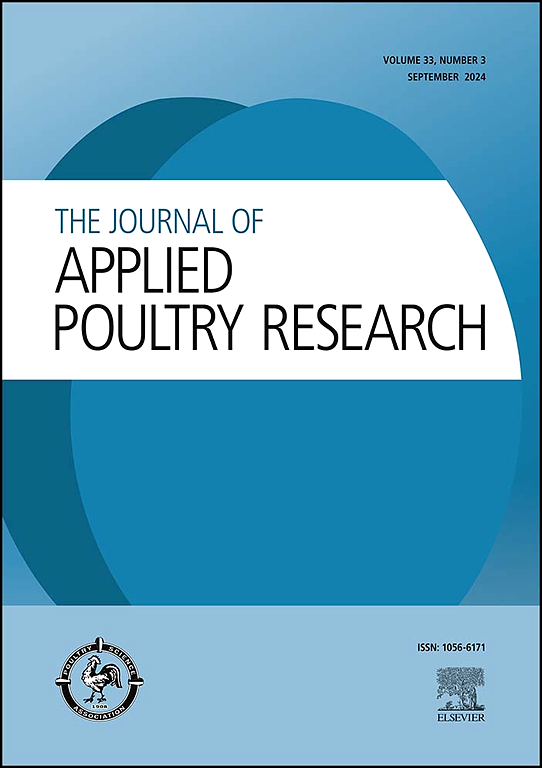Applied research note: Heating system and feed additive effects on foot pad quality, broiler performance, and immune status
IF 2
3区 农林科学
Q2 AGRICULTURE, DAIRY & ANIMAL SCIENCE
引用次数: 0
Abstract
Radiant propane brooders are commonly used to heat poultry houses in the United States. However, brooders combust within the house, releasing moisture into the grow-out environment. The objectives of this study were to investigate the effects of two feed additives (antibiotic and muramidase) provided to broilers reared using two heating systems (external combustion wood boiler heat exchanger or radiant propane brooders), on broiler performance, foot pad quality, and immune status. Two identical experiments were completed, using two identical rooms heated with either radiant propane brooders or a wood boiler heat exchanger. 1,472 Ross-308-AP straight-run broiler chicks were utilized for each experiment, for 35d. Each room contained 32 floor pens. One of four dietary treatments (positive control (PC), negative control (NC) (15 % reduction in digestible amino acids), NC+antibiotic, NC+muramidase) were randomly assigned to each pen within a block. A block consisted of four adjacent floor pens; eight blocks were utilized per room per experiment. Use of a wood boiler heat exchanger reduced d21 litter moisture (P = 0.1013), d23 serum interleukin-6 (P < 0.0001), and d35 foot pad scores (FPS) (P = 0.0112), relative to radiant propane brooders. Diet influenced 0-35d live weight gain (LWG) and FCR. The PC had the highest LWG and lowest FCR, NC had the lowest LWG and highest FCR, with antibiotic and muramidase being intermediate (P < 0.05). Birds fed the PC had higher d35 litter moisture and FPS (P < 0.05). Heating system type did not affect overall performance (P > 0.05). The wood boiler heat exchanger and both tested feed additives had positive influences on broiler production.
应用研究说明:加热系统和饲料添加剂对肉鸡脚垫品质、生产性能和免疫状态的影响
在美国,辐射丙烷孵卵器通常用于加热禽舍。然而,育雏器在房子里燃烧,将水分释放到生长环境中。本研究的目的是研究在两种加热系统(外燃木材锅炉热交换器或辐射丙烷育雏)饲养的肉鸡中添加两种饲料添加剂(抗生素和酶)对肉鸡生产性能、脚垫质量和免疫状态的影响。完成了两个相同的实验,使用两个相同的房间,要么用辐射丙烷孵育器加热,要么用木材锅炉热交换器加热。每次试验选用罗斯-308- ap直列肉鸡1472只,试验期35d。每个房间有32支地板笔。4种饲粮处理(阳性对照(PC)、阴性对照(NC)(可消化氨基酸减少15%)、NC+抗生素、NC+酶酰胺酶)中的一种随机分配到一个区域内的每个栏中。一个街区由四个相邻的地板围栏组成;每个实验每个房间使用8个积木。使用木质锅炉热交换器可降低d21凋落物水分(P = 0.1013), d23血清白细胞介素-6 (P <;0.0001), d35脚垫评分(FPS) (P = 0.0112)。饲粮影响0 ~ 35d的活增重(LWG)和增重比。PC组LWG最高,FCR最低,NC组LWG最低,FCR最高,抗生素和酶居中间(P <;0.05)。饲喂PC的雏鸟d35凋落物水分和FPS (P <;0.05)。供暖系统类型不影响整体性能(P >;0.05)。木材锅炉换热器和两种试验饲料添加剂对肉鸡生产均有积极影响。
本文章由计算机程序翻译,如有差异,请以英文原文为准。
求助全文
约1分钟内获得全文
求助全文
来源期刊

Journal of Applied Poultry Research
农林科学-奶制品与动物科学
CiteScore
4.10
自引率
10.50%
发文量
80
审稿时长
104 days
期刊介绍:
The Journal of Applied Poultry Research (JAPR) publishes original research reports, field reports, and reviews on breeding, hatching, health and disease, layer management, meat bird processing and products, meat bird management, microbiology, food safety, nutrition, environment, sanitation, welfare, and economics. As of January 2020, JAPR will become an Open Access journal with no subscription charges, meaning authors who publish here can make their research immediately, permanently, and freely accessible worldwide while retaining copyright to their work. Papers submitted for publication after October 1, 2019 will be published as Open Access papers.
The readers of JAPR are in education, extension, industry, and government, including research, teaching, administration, veterinary medicine, management, production, quality assurance, product development, and technical services. Nutritionists, breeder flock supervisors, production managers, microbiologists, laboratory personnel, food safety and sanitation managers, poultry processing managers, feed manufacturers, and egg producers use JAPR to keep up with current applied poultry research.
 求助内容:
求助内容: 应助结果提醒方式:
应助结果提醒方式:


